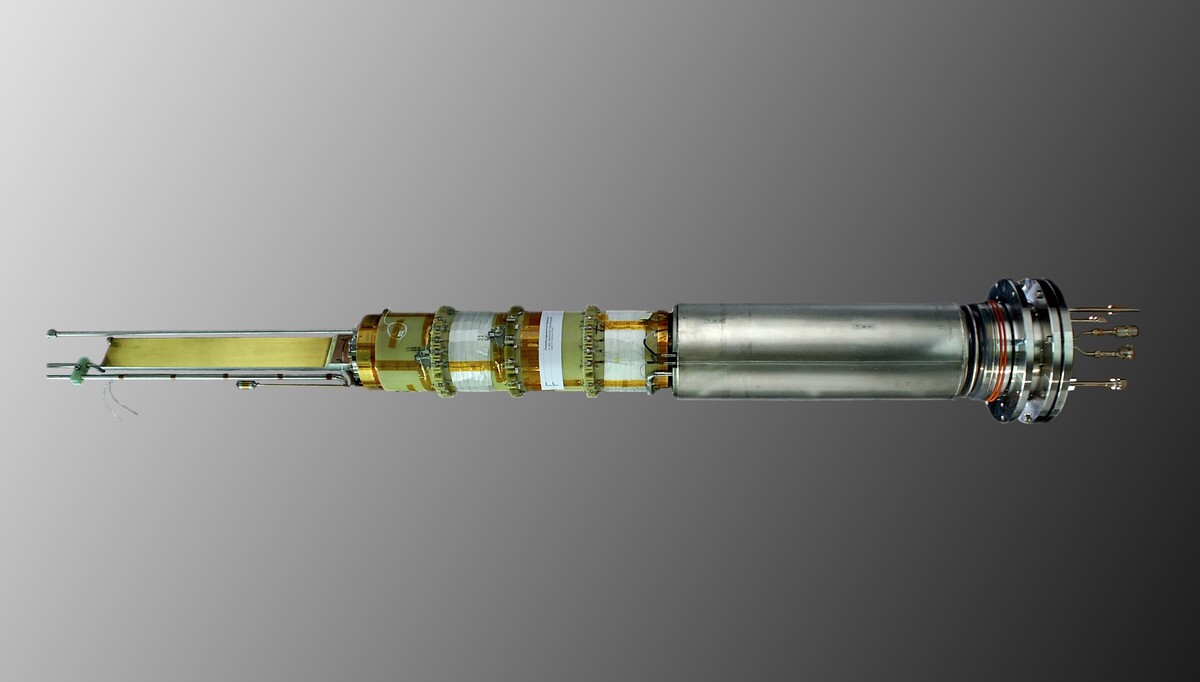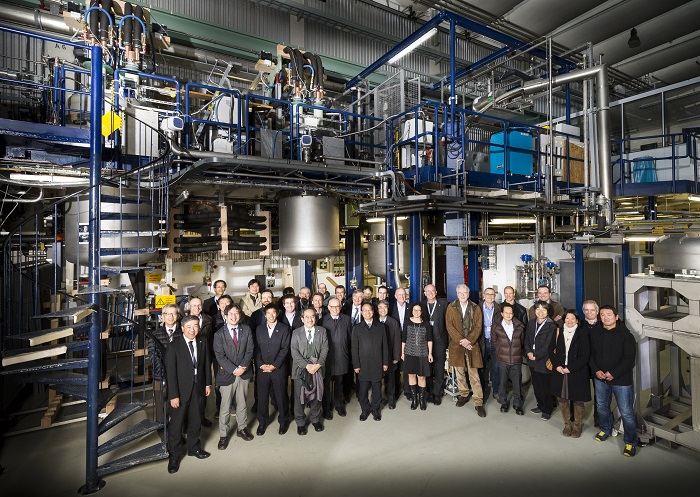Current leads for fusion magnets
Superconducting magnets must be operated at low temperature (e.g. -269°C = 4 Kelvin). In order to be able to cool the magnets down to this temperature, they are thermally insulated and installed in the vacuum of a cryostat.
If high currents of up to 80,000 amperes are to be conducted to the magnets, special current feeders (SZF - see picture on the right) are required with which the current can be conducted through the metallic wall of the cryostat in an electrically insulated manner. Since the current at the lower end of the SZF is to be taken over by the superconductor, the end of the SZF must be in vacuum at the low temperature of -269 °C = 4 K.
Conventional copper SZFs must be kept at the low temperature at the lower end with a high cooling effort. If, however, a high-temperature superconductor (HTS) is installed at the lower end, which is already superconducting at 60 K (-213°C), no losses occur at the lower end of the SBC. Instead of cooling the Cu heat exchanger with 4 K, only 50 K cooling is required, so that approx. 60 K is generated at the upper end of the HTS part.
The cooling of the SZF is thus cheaper by a factor of 3 to 5 depending on the operating mode, which leads to enormous energy savings. For this reason, the ITEP has been driving the development, construction and testing of HTS power supplies for various fusion projects from 1995 to 2017.
Projects
ITER 68,000 Amp HTS power supply demonstrator successfully designed, built and tested.
Within the framework of the European Fusion Technology Program, KIT in cooperation with the CRPP in Villigen (CH) has designed, built, and tested a 70 kA power supply using the HTS material BiSCCO for ITER. Such SZF are to be operated horizontally in ITER. In 2003 + 2004 the power supply was successfully tested under different cooling conditions:
- 50 K helium cooling in heat exchanger and power operation up to 80 kA
- 80 K Helium cooling in heat exchanger and current operation up to 68 kA
- LN2 cooling in heat exchanger and current operation up to 68 kA
16 HTS SZF were provided for the German W7-X project in Greifswald.
For the German fusion project W7-X in Greifswald, KIT has developed, built and tested 16 SZF.
The power supply systems are now in operation at W7-X.
- 18.2 kA SZF, which are operated with the warm end down due to space restrictions.
- Paschen-proof insulation, test voltage 13 kV
- The power supply lines were installed in W7-X except for the 2 prototypes
- These power supply systems have been in use since 10.12.2015
26 HTS SZF provided for JT-60SA in Naka (Japan)
6 HTS SZF 26 kA and 20 HTS SZF with 20 kA developed, built and tested
Current Lead Testing facility Karlsruhe (CuLTKA = SZF-Test facility Karlsruhe) was established to meet the tight schedule of JT-60SA by testing two pairs of power supply lines in parallel.
- High voltage insulation tested up to 21 kV
- All 26 SZF successfully tested and delivered
- These SZF were mounted in JT-60SA supply boxes.
- The first commissioning of JT-60SA is scheduled for 2020
Literature:
R. Heller et al, Experimental results of a 70 kA high temperature superconductor current lead demonstrator for the ITER magnet system, IEEE Trans. Appl. Supercond. 15 (2005) 1496-1499
W.H. Fietz et al, High Temperature Superconductor Current Leads for WENDELSTEIN 7-X and JT-60SA, IEEE Transactions on Applied Superconductivity 19(3), (2009) 2202-2205
S. Drotziger et al, Overview of results from Wendelstein 7-X HTS current lead testing, Fusion Engineering and Design 88, (2013) 1585– 1588
R. Heller et al, Overview of JT-60SA HTS current lead manufacture and testing, IEEE Trans. Appl. Supercond. 28(3) (2018) 4800105

_rdax_1200x1009.png)

_rdax_1200x525.png)
